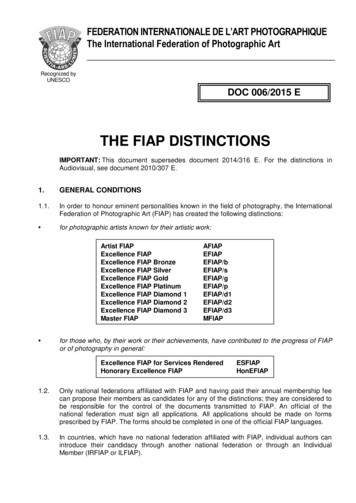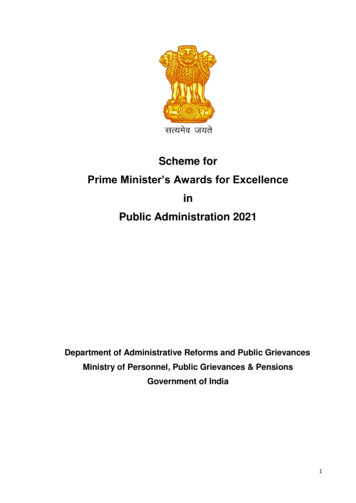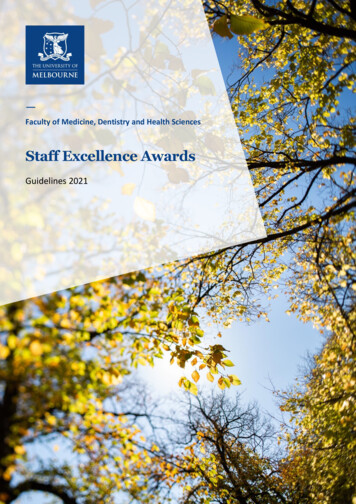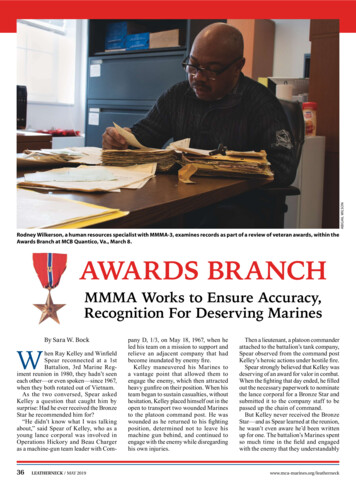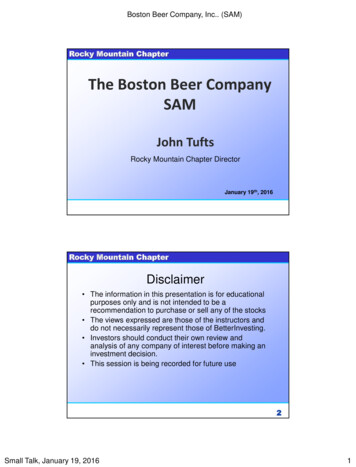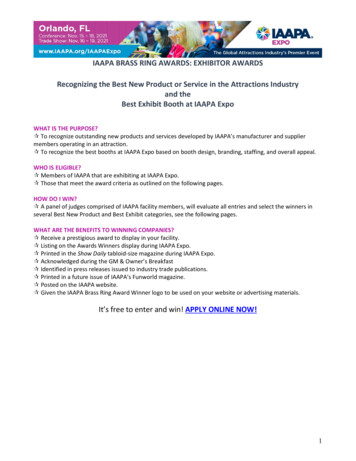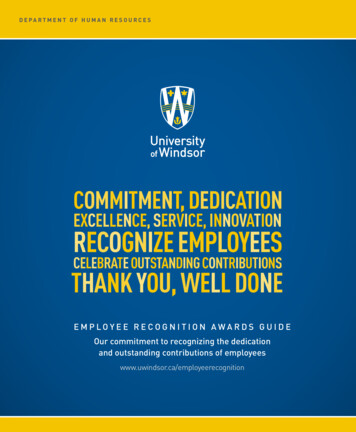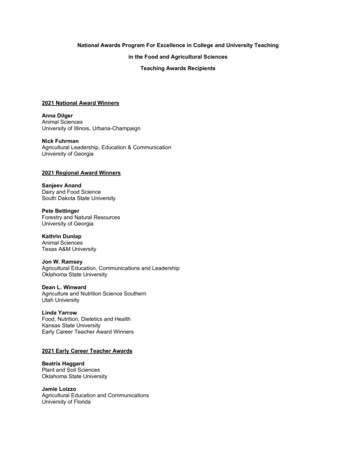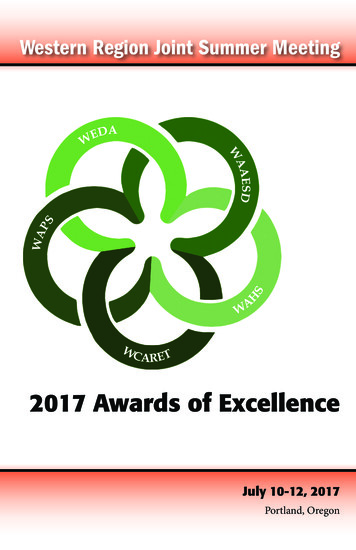
Transcription
Western Region Joint Summer Meeting2017 Awards of ExcellenceJuly 10-12, 2017Portland, Oregon
WEDA Award of ExcellencePrevention of Fruit Cracking in Sweet CherriesOregon State University Extension, College of Agricultural SciencesAbstract: Rain‐induced fruit cracking in sweet cherry causessignificant losses. Fruit are not picked if cracking is greater than25%, because of high labor costs. Faculty at Oregon State Universityproduced a novel, elastic, hydrophobic biofilm. Two applications ofone gallon per acre significantly reduces fruit cracking by 50%.Collaborative trials conducted internationally have all confirmedthese findings. In several instances, the biofilm resulted in highertotal soluble solids (TSS) and increased stem pull force (SPF) thanuntreated control fruit (P 0.001). The biofiom was patented by OSUas SureSealTM and licensed as Parka . Sales have doubled each yearfor the last three years. To date, more than 86,000 gallons of producthave been sold worldwide, generating more than 8.17 million insales at the farm gate. Regionally, the product is used in multiple statesincluding Oregon, Washington, California, Michigan, New York Stateand Georgia. Internationally, the product is being used in Canada,Chile, Turkey and Italy.2 2017 WEDA Award of Excellence
WEDA Award of ExcellenceTeam Members, titles and locationsDr. Clive Kaiser, Associate Professor, Oregon State University,Umatilla County, Milton FreewaterDr. J. Mark Christensen, Professor, College of Pharmacy,Oregon State University, CorvallisLynn Long, Professor, Department of Horticulture, Oregon State University,Wasco County, The DallesDr. Esmaeil Fallahi, Professor, Department of Plant, Soil and EntomologicalSciences, University of Idaho, ParmaClive Kaiser, photo courtesy Oregon State University2017 WEDA Award of Excellence 3
WEDA Award of ExcellenceNew Mexico State University Media Productions& Learning Games LabNew Mexico State University ExtensionAbstract: For more than 20 years, a team of professional mediadevelopers at New Mexico State University Media Productions has beenat the forefront of a national technology shift in Extension educationaland outreach programs, creating effective and innovative technologiesfor national, regional, and state Extension programs. The team includesresearch faculty, programmers, artists and animators, video professionals,writers, and technical support staff. Their video games, mobile apps,podcasts, streaming videos, animations and online learning tools reflectcollaborations with research, teaching and Extension programs at morethan 40 universities, agencies and nonprofits around the nation. Duringthe past two years alone (2015–2016), technology tools created by NMSUMedia Productions have been used more than 13 million times. Thesemultimedia tools support food safety, nutrition, obesity prevention,STEM education, and agricultural outreach and serve 4-H, youth andcollege audiences as well as helping 4-H and Extension personnel workmore efficiently.4 2017 WEDA Award of Excellence
WEDA Award of ExcellenceTeam members (All team members are involved in production, researchand development at New Mexico State University.)David Abraham, Software Developer, ProgrammerAdrian Aguirre, Media Specialist, Project ManagerEsther Aguirre, Fiscal AssistantStanley Carbine, Systems AnalystBarbara Chamberlin, Assistant Department HeadJohn Chamberlin, Program Manager, ProgrammingPatricia Clark, Admin AssistantKathryn-Mae Eiland, Graphic DesignerJeanne Gleason, Department HeadWendy Hamilton, ProfessorLevi Luchini, Graphic DesignerPamela Martinez, Program Manager, MultimediaGerritt McGill, Artist & AnimatorPhilip McVann, Graphic DesignerAmy Muise, EditorConnie Padilla, Program Manager, WebElizabeth Sohn, Project Manager, Graphic DesignerTomilee Turner, Program Manager, Video2017 WEDA Award of Excellence 5
WEDA Honorable MentionExperiential History Education: 4-H Western Heritage ProjectAbstract: The 4-H Western Heritage Project is a participatory living historyprogram for youth ages 9-19 who experience the history of the Americanfrontier period through hands-on learning. While a majority of studentsexpress a lack of interest in history, Participatory Living History (PLH)teaching methodologies show a positive change in youth perspectivestoward learning history and increase interest in history education. A2010 national educational assessment found 88 percent of America’s highschool seniors deficient in U.S. History knowledge. A strong foundationin American history improves the ability of young people to understandculture and society while contributing to an informed citizenry. Byincorporating informal, active learning, the 4-H Western Heritage Projectaddresses traditional deficiencies in history education. Participants utilizerole-playing, games, self-directed learning, group projects, historicalpersona development, and support from enthusiastic leaders to exploremultiple perspectives regarding the history of the American Frontier from1860-1900, including its successes and failures, and racial and social issues.6 2017 WEDA Honorable Mention
WEDA Honorable MentionTeam MembersTodd Kesner, Director of the Montana 4-H Center for Youth DevelopmentWill Abbot, 4-H Volunteer, National Park Service Living Historian andPhotographerKatelyn Andersen, Ravalli County MSU Extension Agent2017 WEDA Honorable Mention 7
WEDA Multistate AwardTraining IPM Professionals in Rural Areas: A Model to AchieveSustainable KnowledgeOregon State UniversityWashington State UniversityUniversity of IdahoAbstract: Integrated Pest Management (IPM) success depends upon theability of practitioners to correctly identify pests, assess their impact, andselect appropriate management tactics. Our multi-state group providesagriculture personnel from the PNW with a high quality, multifacetedtraining program to increase their knowledge of IPM and disseminate thatknowledge throughout the region. Two & half days of experiential learningworkshops teach identification of pest (insects, weeds and diseases) andbeneficial organisms, pest damage assessments, scouting techniques, basicexperimental methods, and reporting skills. Workshops were precededby webinar trainings that demonstrate how to collect and prepare insects,weeds and diseases of major crops, e.g. wheat, potatoes, corn and onions,for identification. Participants were asked to initiate their own outreachefforts after taking the course. Impacts have been vast resulting in lesscalls to extension and increased use of IPM and plant productivity (http://extension.oregonstate.edu/umatilla/ipm).8 2017 WEDA Multistate Award
WEDA Multistate AwardTeam MembersSilvia Rondon, PhD, Associate Professor, Extension Entomologist Specialist,Oregon State University, Hermiston Agricultural Research and ExtensionCenter, Crop and Soil Sciences, Umatilla County, Hermiston, Oregon.Stuart Reitz, PhD, Professor and Extension Faculty Cropping Systems, OregonState University, Malheur County, Crop and Soil Sciences, Ontario Oregon.Kenneth Frost, PhD, Assistant Professor and Extension Plant Pathologist, OregonState University, Hermiston Agricultural Research and Extension Center,Botany and Plant Pathology, Hermiston Oregon.Steve Van Vleet, PhD, Associate Professor and Extension Educator, WashingtonState University, Center for Sustaining Agriculture and Natural Resources,Colfax Washington.Pamela Hutchinson, PhD, Associate Professor and Weed Extension, University ofIdaho, Aberdeen Research and Extension Center, Aberdeen Idaho.Silvia Rondon, photo courtesy Oregon State University2017 WEDA Multistate Award 9
Excellence in Multistate ResearchWestern Region Excellence in Multistate Research AwardW3112 Reproductive Performance in Domestic RuminantsAbstract: The livestock industry is a critical component of theagricultural industry. The dairy, beef, and sheep industries togethercontribute approximately 81.5 billion in farm receipts and an estimatedoverall production value of 192 billion. Poor reproductive efficiencyin domestic ruminants is widely regarded as the most limiting factor toprofitability and sustainability of animal production systems throughoutthe nation. In the beef industry alone, the cost of infertility to U.S.producers was estimated to be over 1.06 billion annually.For the last 47 years, members of W3112, Reproductive Performance inDomestic Ruminants, have brought diverse expertise to bear on factorsthat limit fertility in ruminants and to provide products, techniques, andoutreach materials for the benefit of livestock producers. For example:- Members designed more effective estrus synchronization methodsand new protocols that increased pregnancy rates through artificialinsemination by 10-15%, which could result in 400 million in economicimpact if implemented on 10% of U.S. beef and dairy cows.- Research has helped producers identify animals that most effectivelyuse feed resources (i.e., they eat most of the predicted amount of feed),saving producers 20 to 40 per cow. On a national basis, this technologyhas the potential to save cow-calf producers 800 million to 1.6 billionin annual feed costs.- Developed methods to control bovine viral diarrhea virus thatcould save U.S. cow-calf producers 481 to 632.5 million annually byincreasing calf viability.10 2017 Western Region Excellence in Multistate Research
Excellence in Multistate ResearchThomas Spencer and Holly Neibergs from Washington State UniversityFinally, collaborative research activity carried out through this projecthas leveraged more than 18.4 million dollars in grant funding toparticipating State Agricultural Experiment Stations between 2011and 2016.Additional Cooperating agencies include State Agricultural Departmentsand other USDA agencies including Natural Resource ConservationService. When appropriate, collaborative activities have included privateindustry including Eli Lilly, Pharmacia, Select Sires, and AmericanBreeders Service as well as other businesses serving the reproductionsciences in industry.2017 Western Region Excellence in Multistate Research 11
Excellence in Multistate ResearchW3112 Reproductive Performance in Domestic RuminantsProject MembersMilan ShipkaUniversity of Alaska, FairbanksJohn B. HallUniversity of IdahoZelieann CraigUniversity of ArizonaFelipe CardosoUniversity of IllinoisRandy L. BoganUniversity of ArizonaJoann KoubaKansas State UniversitySean LimesandUniversity of ArizonaTim RozellKansas State UniversityRick W. RorieUniversity of ArkansasD. M. GriegerKansas State UniversityAnna DenicolUniversity of California, DavisKarol FikeKansas State UniversityT.E. AdamsUniversity of California, DavisGlen T. Gentry Jr.Louisiana State UniversityPablo J. RossUniversity of California, DavisC. WallaceUniversity of MaineThomas HansenColorado State UniversityJames IrelandMichigan State UniversityRuss AnthonyColorado State UniversityG. SmithMichigan State UniversityNett TorranceColorado State UniversityAllen BridgesUniversity of MinnesotaColin ClayColorado State UniversityJon E. WheatonUniversity of MinnesotaSteven ZinnUniversity of Connecticut, StorrsCaleb LemleyMississippi State UniversityKristen E. GovoniUniversity of Connecticut, StorrsPeter SutovskyUniversity of Missouri12 2017 Western Region Excellence in Multistate Research
Excellence in Multistate ResearchMichael SmithUniversity of MissouriTom GearyUSDA-ARSJames BerardinelliMontana State UniversityJohn R. StevensUtah State UniversityLigia PrezottoMontana State UniversityAlan D. EalyVirginia Polytechnic Institute andState UniversityAndrea S. CuppUniversity of NebraskaMike B. TeglasUniversity of NevadaRyan L. AshleyNew Mexico State UniversityD. M. HallfordNew Mexico State UniversityKimberly VonnahmeNorth Dakota State UniversityWilliam PopeOhio State UniversityThomas E. SpencerWashington State UniversityJames K. PruWashington State UniversityBrenda M. AlexanderUniversity of WyomingMichael L. DayUniversity of WyomingStephen P. FordOhio State UniversityKames E. KinderOhio State UniversityMichelle KutzlerOregon State UniversityWansheng LiuPennsylvania StateKy G. PohlerUniversity of TennesseeRonald D. RandelTexas AgriLife Research2017 Western Region Excellence in Multistate Research 13
W-APS Teaching ExcellenceWestern Region Award of Excellencein College and University Teachingin Food and Agricultural SciencesDr. William WaltonDepartment of Entomology atUC Riverside· Professor and Vice Chair of Departmentof Entomology at UC Riverside(hired as Assistant Prof in 1995 afterPhD at U of Maryland and threepost-docs, including one at Cornell)· research expertise in aquatic ecology· supervised more than 30 undergraduateresearchers since 2007· teaching evaluations have been nearly perfect· received UCR’s Distinguished Teaching Award for 2016-2017· National Academies Education Fellow for Life Sciences· has a “long history of teaching innovation” that includes making coursematerials accessible to students at other universities around the country,and incorporating web-based population modeling for an Insect Ecologycourse that allowed “students to perform their own population growthsimulations, and to examine how changes in the variables affect themodel output.”14 2017 W-APS Teaching Excellence
W-APS Teaching Excellence· for an aquatic entomology course, he “developed an innovative laboratorythat includes a physical and biological assessment of a local watershed.”· a former student wrote, “His model for engaging undergraduates incollaborative research allows newer assistants to actively learn aboutresearch endeavors while enabling older assistants to learn importantmentoring skills and develop scholarly independence.” Also, “His exampleof education is both humbling and inspiring. At such a large universitywhere many professors will focus on their own productivity, Dr. Waltontruly goes above and beyond. His natural compassion is evident throughhis passionate dedication to student learning and achievement. Hisunwavering enthusiasm for his field is apparent with his animated lecturesand quirky humor. Motivated by genuine interest in student learning andachievement, and powered by ingenuity, Dr. Walton has found ways toeducate the student as a whole, not just cover the relevant material.”2017 W-APS Teaching Excellence 15
Western Region Joint Summer Meeting hosted by:Oregon State University Extension Service prohibits discrimination in all its programs, services,activities and materials on the basis of race, color, national origin, religion, sex, gender identity(including gender expression), sexual orientation, disability, age, marital status, familial/parentalstatus, income derived from a public assistance program, political beliefs, genetic information,veteran’s status, reprisal or retaliation for prior civil rights activity. Not all prohibited bases applyto all programs.
New Mexico State University Extension Abstract: For more than 20 years, a team of professional media developers at New Mexico State University Media Productions has been at the forefront of a national technology shift in Extension educational and outreach programs, creating effective and innovative technologies
